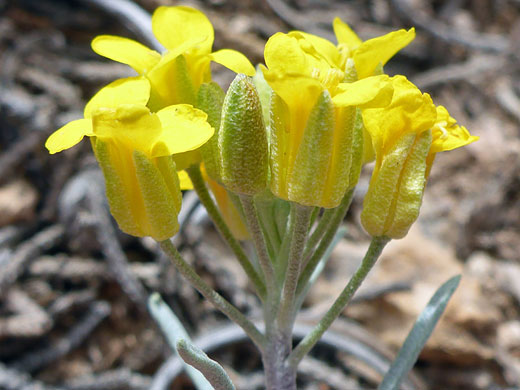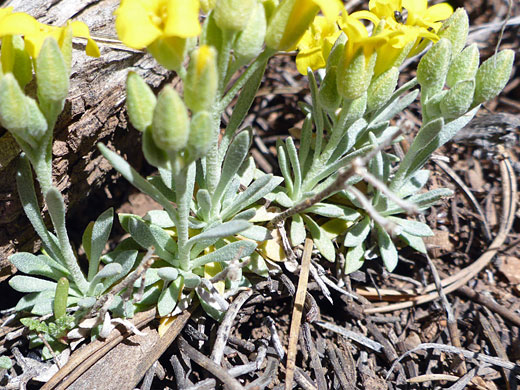Common name:
Mid bladderpod
Family:
Scientific name:
Physaria intermedia
Synonym:
Lesquerella intermedia
Main flower color:
Range:
Utah, north Arizona and northwest New Mexico
Height:
Up to 10 inches
Habitat:
Dry washes, open hillsides; gravelly or rocky places, pinyon-juniper woodland, up to 7,500 feet
Leaves:
Thick, narrow, linear to oblanceolate, up to 2 inches long
Season:
April to August
Leaves of physaria intermedia grow mostly from the base, forming a thick, tangled clump, mixed with dead stems and leaves from previous seasons. Stems are stout and woody, and they and the leaves are covered by short, dense, branched hairs, which impart a silvery grey color. The narrow leaves are often rolled up at the edges, and they usually have blunt tips. Stems are unbranched, growing upwards or at an angle. Basal leaves tend to be slightly longer than those on the stem.
Sepals are in two pairs, slightly different in shape, but all four are yellowish green in color and about a quarter of an inch in length. The four yellow petals are up to twice as long, spatulate to oblong in shape, relatively broad at the base and flat at the top. Flowers are usually bilaterally rather than radially symmetric; each petal is closer to one neighbor than the other.
Sepals are in two pairs, slightly different in shape, but all four are yellowish green in color and about a quarter of an inch in length. The four yellow petals are up to twice as long, spatulate to oblong in shape, relatively broad at the base and flat at the top. Flowers are usually bilaterally rather than radially symmetric; each petal is closer to one neighbor than the other.
All Contents © Copyright The American Southwest | Comments and Questions | Contribute | Site Map






